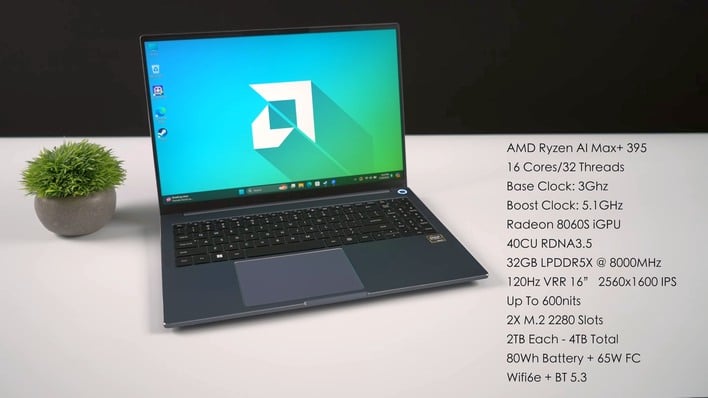AIM Strix Halo Gaming Laptop With Ryzen AI Max+ Shoots For A Sub-$1K Price
The Ryzen AI Max+ 395 is AMD's halo-tier mobile APU, boasting 16 full-fat desktop Zen 5 CPU cores and a 40-CU RDNA 3.5 integrated GPU—officially branded the Radeon 8060S. It's a chip we've tested before in ASUS' ROG Flow Z13 tablet and, currently, in the HP Z2 Mini G1a workstation. In both cases, performance has been impressive in raw compute tasks and AI workloads, but pretty meager on the GPU side relative to price. That's been the tradeoff: bleeding-edge efficiency and iGPU prowess, but not quite enough gaming muscle to justify two grand or more if that's your use case.
According to YouTuber ETA PRIME, who got his hands on an early AIM unit, this new laptop offers the same Ryzen AI Max+ 395 chip in a minimalist aluminum chassis with a 16-inch, 2560×1600 IPS panel (120 Hz VRR, 600 nits), 32GB of LPDDR5X RAM, and dual M.2 slots. In his testing, the iGPU isn't quite desktop-class, but it handles modern AAA games surprisingly well—think 60+ FPS in Cyberpunk 2077 at 1600p with FSR, and similar numbers in other well-optimized titles like Forza Horizon 5. Performance is limited quite a bit by the 65W thermal envelope, but that's to be expected in a thin laptop form factor; we encountered similar issues when testing the ROG Flow z13.
Overall, it's a fairly unremarkable laptop, but the real draw of this system is the purported price target. AIM claims that it is aiming for sub-$1,000, but ETA PRIME seems skeptical, and so are we. There's currently no Strix Halo machine available under $1,499—GMKTec's mini-desktop is the cheapest we've seen, and that's without a battery, keyboard, display, or speakers. If AIM really delivers this laptop at $999 with these specs, it would be an absolute steal—but we'll believe it when it's in carts.
You can watch ETA PRIME's full hands-on above for more detail on thermals, game performance, and build quality. Until this system hits store shelves, this is definitely one to keep an eye on. If nothing else, it could be a sign that Strix Halo is finally starting to trickle down from ultra-premium territory—and that's good news for anyone waiting on AMD's monster APU to become a little less… monstrous-ly priced.





